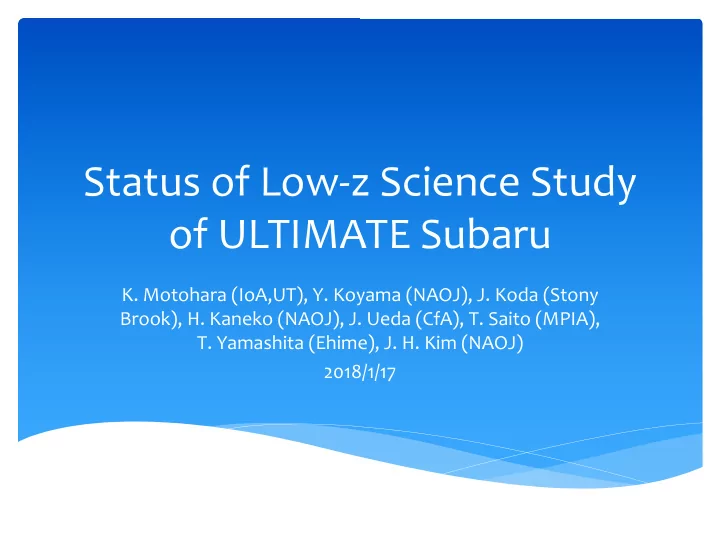

Status of Low-z Science Study of ULTIMATE Subaru K. Motohara (IoA,UT), Y. Koyama (NAOJ), J. Koda (Stony Brook), H. Kaneko (NAOJ), J. Ueda (CfA), T. Saito (MPIA), T. Yamashita (Ehime), J. H. Kim (NAOJ) 2018/1/17
Team Members * K. Motohara (Chair : U. Tokyo) * Y. Koyama (Co-Chair : Subaru/NAOJ) * J. Koda (Stony Brook) * H. Kaneko (NRO/NAOJ) * J. Ueda (CfA/Harvard) * T. Saito (MPIA) * T. Yamashita (Ehime) * J. H. Kim (Subaru/NAOJ) * D. Iono (ALMA/NAOJ) * T. Takeuchi (Nagoya U.) * K. Sorai (Hokkaido U.)
ZOOM Meetings * 3 ZOOM Meetings so far * 2017/10/12 * 2017/12/8 * 2018/1/12 * Geological distance is a problem * Esp. timezone * Welcome new members from anywhere!
Basic Survey Strategy * Advantage of ULTIMATE * High spatial resolution with wide FoV * Probe internal physical structure of nearby galaxies * Multiple emission line diagnosis may be the key
Emission Lines in the NIR * HI Lines (Br-G, Br-D, Pa-A, Pa-B) : HII region * H2 Lines : Warm molecular gas (PDR, SNR, etc) * Rotation-vibration lines * [FeII] : SNR, PDR * (CO absorption) Evolved stars Piqueras Lopez+12
Science Cases * Resolved SF, KS-law using Br-G and Pa-B * Ram-Pressure Stripping in Local Galaxy Clusters * Intragroup Starburst in Compact Groups of Galaxies * Formation and Evolution of Stellar Clusters * ANU, Taiwan proposals !! * Nearby AGN ionization
NIR Narrow-band Imaging of Nearby Galaxies (Koda) Piqueras Lopez+12 * Overall understanding of ISM physics in galaxies * Obscured regions * NIR emission line is crucial * NBFs imaging * 4 NBF x redshift bins * SFR indicator : Pa-B/Br-G * Extinction correction as well * Shock and PDR: H2 rot-vib lines * Multiple line diagnosis
HII Mapping Survey of Local Galaxies (Kaneko) * Star-Formation – GMC relation * What makes the difference of observed Disk/Starburst? * More accurate understanding of K-S law * GMC scale resolution (fewx10pc) * Extinction free SFR probe => Hydrogen Recombination Lines * NBF imaging of Nearby Galaxies * 2 NBFs x redshift bins * Pa-B * Br-G * Seeing 0.2” ó 50pc @ z=0.01 Daddi+10
Formation and Evolution of Stellar Clusters (Kim) * Stellar Clusters : Probe of SFH, dynamics and structure * Demographic census of SC in galaxies * High spatial resolution is required to avoid contamination from surroundings * Broad-band Imaging of nearby galaxies * CC diagram => age, mass * Additional Br-G/Pa-B NB imaging => more precise age/mass estimate
Ram Pressure Stripping in Local Galaxy Clusters (Ueda, Saito) * Probe galaxy quenching mechanism in high density regions * Wide field H2 observations of cluster galaxies * Use H2 as a shock indicator * Start with MOS spectroscopy (GLAO + MOIRCS) * Multi-object IFU at K-band desired
Intragroup Starbursts in Compact Groups of Galaxies (Ueda, Saito) * CGs (density between field and cluster) shows various environment effects * Morphology-density relation is not so clear * Important to understand IGM physics * Targets : HCGs * z<0.06 * D<20 arcmin * Wide field Br-G NB Image * 1NBF x redshift bins * H2 lines may be taken by targeted spec. * Multi-object IFU at K-band desired Stephan’s Quintet shows strong shock in IGM
Survey Targets * Narrow-band Imaging Survey of Nearby Galaxies * NGC, UNGC catalog * 208 / 114 galaxies observable with Diameter > 5arcmin * Some of them are cluster galaxies * Nearby LIRGs * 153 U/LIRGS observable, which is also included in GOALS * Choose from SFR-M* parameter space * E.g.) 3 SFR, 3 M* bins * ~10 galaxies / bin => 100 galaxies in total
NBF Observations * BBF : JHKs * Various NBFs * Br-G : 2.166μm * Pa-B : 1.282μm * H2(v=1-0)S(1) : 2.122μm * H2(v=1-0)S(3) : 1.958μm * ([Fe II] : 1.644μm, H2(v=2-1)S(1)..) * Several sets for different redshifts * 30min/NBF, 30min/BBF * 3.5hr/galaxy => 2 galaxies/night * 100 galaxies / 50 nights
Summary * Emission-line imaging is crucial for nearby galaxy science * Br-G, Pa-B, H2(v=1-0)S(1), H2(v=1-0)S(3) * K-band MOS/Multi-IFS * May have good synergy with ALMA/EVLA * Nearby Galaxy Survey * From NGC, UNGC catalog * 50nights / 100 galaxies
Backup Slides
H2 Line Diagnosis Model 1 : n_H=1e3 + UV fluorescence Model 2 : n_H=1e4 + UV fluorescence Model 3 : thermalized T=2000K Piqueras Lopez+12
NBF or Tunable Filter * Current requests to NBFs * Br-G, Pa-B, H2(v=1-0)S(1) , H2(v=1-0)S(3), H2(v=2-1)S(1) * R=100 : Δz=0.01 * 4~5 filters per redshift bin * Fabry-Perot Tunable Filter? * Not a established technology * Wavelength calibration is critical, and challenging * Applying to KAKENHI for R&D (Takahashi et al.) Ethalon of JWST/TFI Doyon et al., ProcSPIE 7731, 77310F (2010)
Emission-Line Sensitivity * SFR density sensitivity of HAWK-I/VLT ETC (3600sec, 1arcsec^2 aperture): Br-G : ΣSFR=2e-7Msun/yr/pc^2 (5sigma) Pa-B : ΣSFR=3e-8Msun/yr/pc^2 (5sigma)
Comparable with Pa-A obs by miniTAO 1m * Komugi, Tateuchi, KM+12 * 1.5hr exposure
Recommend
More recommend